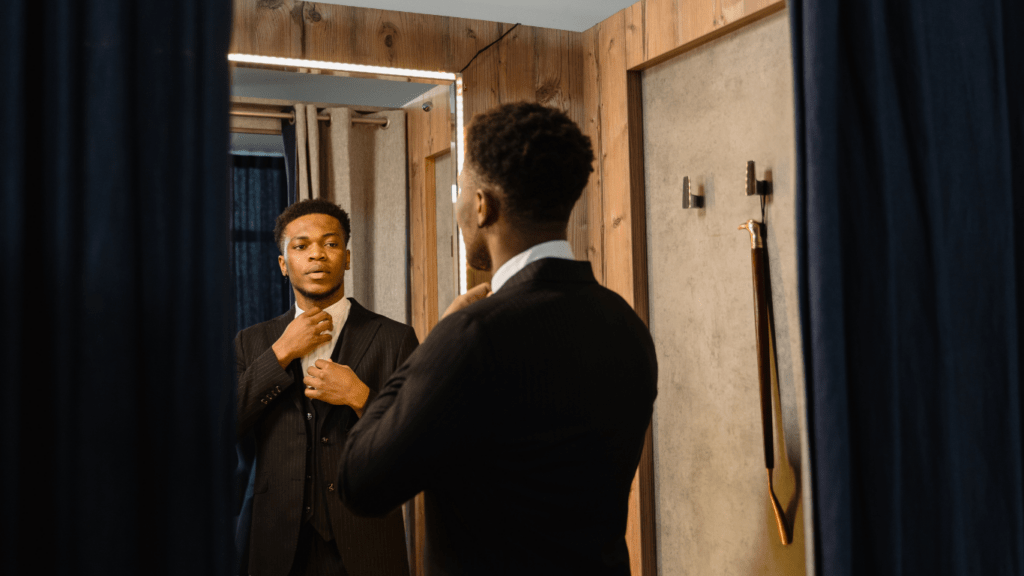Historical Significance of the Suit
The modern suit as we know it has roots stretching back to the early 19th century. Inspired by the British aristocracy, men adopted the suit as a symbol of elegance and status. By the mid-1800s, Beau Brummell revolutionized men’s fashion by popularizing the concept of minimalism, advocating for fitted garments and simplicity over opulence.
During the Industrial Revolution, suits transitioned into the everyday attire for the burgeoning middle class. Tailored suits became a marker of professionalism and respectability, essential for businessmen navigating the corporate world.
By World War II, the suit had firmly entrenched itself as a global standard. Uniformity became a prevailing theme, mirroring the collective wartime efforts. Post-war, the Golden Age of Hollywood glamorized the suit further, with iconic figures like Cary Grant and Humphrey Bogart showcasing its timeless appeal.
The 1960s saw a shift with the Mod movement and the rise of British fashion icons like The Beatles. Their tailored suits with distinct styles brought a youthful twist to the classic attire, making it relevant for new generations. The suit’s adaptability continued into the late 20th century, with designers introducing various cuts, fabrics, and styles to reflect contemporary tastes.
In the modern era, despite casual wear gaining popularity, the suit remains a powerful symbol of professionalism and style. Events like weddings, formal gatherings, and business meetings still see the suit as the preferred attire, reflecting its lasting relevance.
Key Elements of a Well-Fitted Suit

A well-fitted suit embodies elegance, style, and professionalism. These suits stand out due to their perfect fit, high-quality materials, and timeless design.
Tailoring
Tailoring is crucial for a well-fitted suit. Precision in measurements and adjustments ensures the suit complements the wearer’s body shape. Key areas include the:
- shoulders
- chest
- waist
- length of the sleeves
- trousers
For example, shoulder seams should align perfectly with the wearer’s natural shoulder line, while the jacket’s waist should fit snugly without being tight.
Fabric Selection
Fabric selection significantly impacts the suit’s appearance and durability. High-quality fabrics, such as wool, cotton, and linen, offer comfort and longevity. For instance, wool suits are versatile and suitable for various climates. Cotton suits provide breathability, making them ideal for warmer weather. Fabric weight and weave also play critical roles, affecting the suit’s drape and overall look.
Design and Style
Design and style reflect the suit’s aesthetics and versatility.
Classic designs include single-breasted and double-breasted options.The choice between notch, peak, or shawl lapels can further distinguish the suit’s look. For examples, single-breasted suits with notch lapels are versatile for both business and casual settings, whereas double-breasted suits with peak lapels offer a more formal appearance. A well-fitted suit should also consider the number of buttons and vent styles to match the wearer’s preference and occasion.
The Psychological Impact of Wearing a Suit
Wearing a well-fitted suit goes beyond aesthetics. It has profound psychological effects on both the wearer and those they interact with.
Confidence Boost
Wearing a suit often enhances confidence. When I wear a suit, I notice an immediate change in my self-perception. Formal attire can improve focus, which boosts productivity. A study by the Journal of Experimental Social Psychology found that subjects taking a test performed better when wearing formal clothing, suggesting a cognitive benefit from dressing well. This improved self-assurance often translates to more assertive behavior in professional and social settings.
Perception by Others
Others’ perceptions shift when I wear a suit. People often associate suits with professionalism and competence. A study published in the International Journal of Fashion Design, Technology and Education showed that individuals in suits were perceived as more trustworthy and authoritative. This change in perception can lead to better interpersonal interactions and even enhance career prospects. Wearing a suit can thus positively influence how others view and respond to me, further reinforcing the benefits of donning well-fitted formal attire.
Modern Trends and Innovations
Modern suits offer more than traditional elegance, integrating sustainability and technology to meet evolving consumer demands.
Sustainable Suiting
Sustainable practices now shape the suiting industry. Many brands use organic wool, recycled fibers, and eco-friendly dyes. For example, companies like Patagonia and Stella McCartney focus on reducing their environmental impact. This shift reduces waste and appeals to eco-conscious consumers. Ethical manufacturing practices also play a key role, ensuring fair wages and safe working conditions for garment workers.
Technology in Tailoring
Technology revolutionizes tailoring, enhancing precision and customization. 3D body scanning provides accurate measurements for a perfect fit. Brands like Indochino and SuitSupply use these scans to create made-to-measure suits. Additionally, advanced fabrics improve comfort and durability. For instance, moisture-wicking and wrinkle-resistant materials ensure suits look sharp all day. Artificial Intelligence (AI) also aids in predicting fashion trends, helping designers create contemporary, yet timeless pieces.
Caring for Your Suit
Proper suit care ensures longevity and maintains its sharp appearance. Follow these steps to keep your suit looking pristine.
Cleaning and Maintenance
Dry clean suits sparingly. Over-cleaning can degrade fabric fibers. Aim for once or twice a season unless heavily soiled. In between, spot clean with a damp cloth and mild detergent for minor stains.
Brush suits regularly. Use a soft-bristle brush to remove dust and dirt. This prevents particles from embedding into the fabric.
Rotate suits to prolong their lifespan. Wear each suit once or twice a week to reduce wear and tear on a single outfit.
Storing Tips
Hang suits on sturdy, well-shaped hangers.
- Use wooden or padded hangers to maintain shoulder structure.
- A well-shaped hanger supports the jacket’s form.
- Store suits in breathable garment bags.
- Avoid plastic covers; they trap moisture and encourage mildew.
- Use canvas or cotton bags instead.
- Keep suits in a cool, dry place. Avoid areas with high humidity to prevent mold and moth infestations.
- Cedar wood can absorb moisture and repel insects, making it a good addition to your closet.


 Fashion and Beauty Editor-in-Chief at Divine Glamour Trail, is the creator of the platform, which is dedicated to sharing the latest trends in hairstyles, beauty, and skincare. With a passion for timeless fashion and practical style advice, Virginiana provides updates, tips, and insights that inspire readers to elevate their personal style. Her platform blends modern trends with enduring elegance, helping individuals feel confident and look their best.
Fashion and Beauty Editor-in-Chief at Divine Glamour Trail, is the creator of the platform, which is dedicated to sharing the latest trends in hairstyles, beauty, and skincare. With a passion for timeless fashion and practical style advice, Virginiana provides updates, tips, and insights that inspire readers to elevate their personal style. Her platform blends modern trends with enduring elegance, helping individuals feel confident and look their best.
